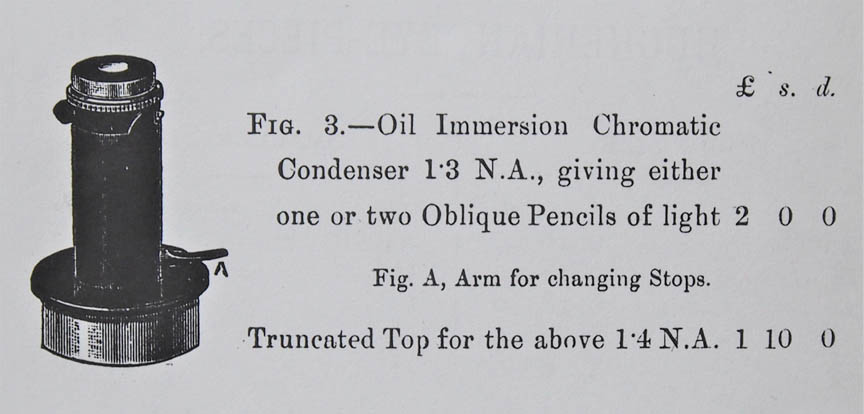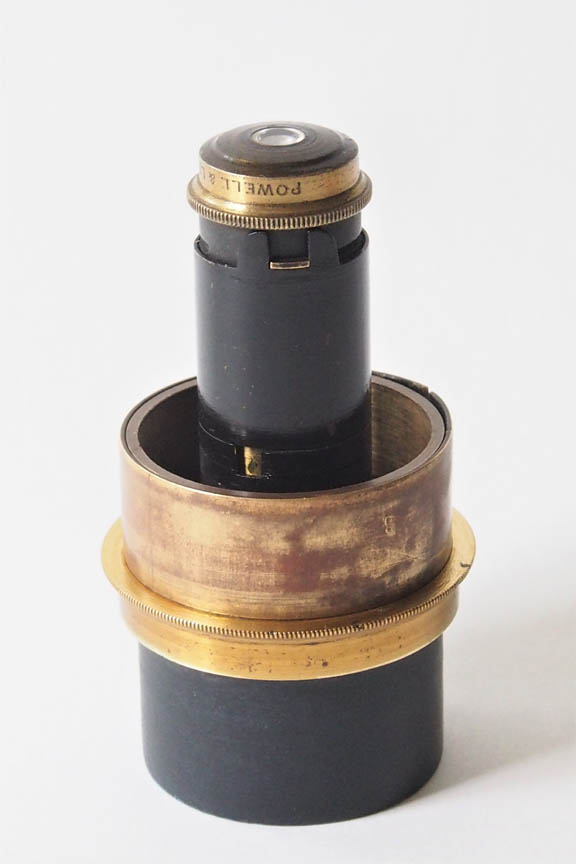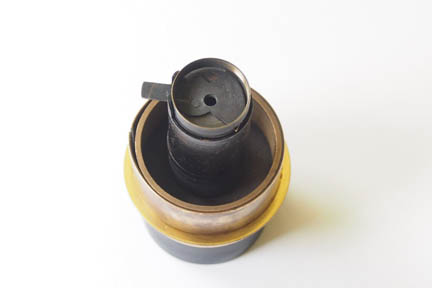MICROSCOPE-ANTIQUES.COM © 2013-23.
POWELL AND LEALAND CONDENSER
C. 1891
SIGNED ON THE CONDENSER: POWELL & LEALAND
MODEL: HIGH POWER OIL IMMERSION ACHROMATIC CONDENSER
CLICK HERE TO RETURN TO THE P & L BINOCULAR NUMBER 1 PAGE


With the development of their first oil immersion objectives, Powell & Lealand's dry achromatic condenser, with a maximum N.A. of 0.99 no longer provided a sufficiently large cone of light. To take full advantage of the higher resolving power, they first produced a chromatic (i.e. not achromatic and on the principle of a small Abbe) oil immersion condenser in 1880, which was principally designed to provide oblique illumination. In its original form, this had a total aperture (N.A.)of 1.30.

Its operation is quite ingenious, and consists of a rotating sleeve, with at its top end both a fixed- and a rotating diaphragm, the combination of which results in 4 different configurations: one central aperture for focusing/centering purposes, two oblique illumination pencils with one at 0 degrees, and the other at 90 degrees respectively, and a fourth combining the latter two, i.e. at right angles of each other (click on the image to the left to see the different positions). The optical element has a focal length of 1/5 inch, and in this example is truncated
, i.e. all optical parts are combined in a single brass cell, which screws into the top of the sleeve. In their 1895 catalogue, Powell & Lealand advertize this version as having an N.A. of 1.40, the cost being 1 Pound 10 Shillings extra. This condenser was also made for other microscope makers, such as the firm of Watson, which at that stage did not as yet make their own oil immersion condensers. This particular example was made to be fitted into an under stage sleeve. The present owner has added an adaptor which allows it to be used in the original P & L substage. The engraved illustration shows the condenser in its usual guise.

With the development of their first oil immersion objectives, Powell & Lealand's dry achromatic condenser, with a maximum N.A. of 0.99 no longer provided a sufficiently large cone of light. To take full advantage of the higher resolving power, they first produced a chromatic (i.e. not achromatic and on the principle of a small Abbe) oil immersion condenser in 1880, which was principally designed to provide oblique illumination. In its original form, this had a total aperture (N.A.)of 1.30.

Its operation is quite ingenious, and consists of a rotating sleeve, with at its top end both a fixed- and a rotating diaphragm, the combination of which results in 4 different configurations: one central aperture for focusing/centering purposes, two oblique illumination pencils with one at 0 degrees, and the other at 90 degrees respectively, and a fourth combining the latter two, i.e. at right angles of each other (click on the image to the left to see the different positions). The optical element has a focal length of 1/5 inch, and in this example is
truncated, i.e. all optical parts are combined in a single brass cell, which screws into the top of the sleeve. In their 1895 catalogue, Powell & Lealand advertize this version as having an N.A. of 1.40, the cost being 1 Pound 10 Shillings extra. This condenser was also made for other microscope makers, such as the firm of Watson, which at that stage did not as yet make their own oil immersion condensers. This particular example was made to be fitted into an under stage sleeve. The present owner has added an adaptor which allows it to be used in the original P & L substage. The engraved illustration shows the condenser in its usual guise.